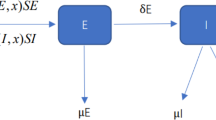Abstract
Mathematical models have long been used to better understand disease transmission dynamics and how to effectively control them. Here, a chancroid infection model is presented and analyzed. The disease-free equilibrium is shown to be globally asymptotically stable when the reproduction number is less than unity. High levels of treatment are shown to reduce the reproduction number suggesting that treatment has the potential to control chancroid infections in any given community. This result is also supported by numerical simulations which show a decline in chancroid cases whenever the reproduction number is less than unity.




Similar content being viewed by others
References
American Academy of Pediatrics (2000) Chancroid. In: Pickering LK (ed) 2000 Red book: report of the Committee on Infectious Diseases, 25th edn. American Academy of Pediatrics, Elk Grove Village, pp 203–205
Ballard RC, Ye H, Matta A, Dangor Y, Radebe F (1996) Treatment of chancroid with azithromycin. Int J STD AIDS 7(Supp. 11):9–12
Bhunu CP, Mushayabasa S (2011a) Assessing the effects of intravenous drug use on Hepatitis C transmission dynamics. J Biol Syst 19(3):1–14
Bhunu CP, Mushayabasa S (2011b) Transmission dynamics of richomonas vaginalis: A mathematical approach. J Math Anal Appl 379:852–860
Bhunu CP, Mushayabasa S, Tchuenche JM (2011) A theoretical assessment of the effects of smoking on the transmission dynamics of tuberculosis. Bullet Math Biol 73:1333–1357
Birkhoff G, Rota GC (1982) Ordinary differential equations. Needham Heights, Ginn
Castillo-Chavez C, Feng Z and Huang W (2002) On the computation of R0 and its role on global stability. In: Castillo-Chavez C et al (eds) Mathematical approaches for emerging and reemerging infectious diseases: an introduction, vol 125, pp 229–250. IMA
Chin J (ed) (2000) Chancroid. In: Control of communicable diseases manual, 17th edn. American Public Health Association, Washington, pp 90–91
Dangor Y, Ballard RC, Exposto F, GlendaF. Steven DM, Hendrik KJ (1990) Accuracy of clinical diagnosis of genital ulcer disease. Sexual Transmit Dis 17(4):184–189
Frisch M, Hviid A (2006) Childhood family correlates of heterosexual and homosexual marriages: A national cohort study of two million danes. Arch Sex Behav 35:533–547
Hansen T (2008) Legalizing same-sex marriage will increase prevalence of homosexuality: research provides significant evidence. http://www.drtraycehansen.com/Pages/writings_legalizing.html
Latif AS (1982) Thiamphenicol in the treatment of chancroid. Br J Vener Dis 58:54–55
Male Health Center (2006) Texas, USA. http://www.malehealthcenter.com/c_std.html
Malonza IM, Tyndall MW, Ndinya-Achola JO, Maclean I, Omar S, MacDonald KS, Perriens J, Orle K, Plummer FA, Ronald AR, Moses S (1999) A randomized, double-blind, placebo controlled trial of single-dose ciprofloxacin versus erythromycin for the treatment of chancroid in Nairobi, Kenya. J Infect Dis 180(6):1886–1893
NationMaster-Zimbabwean People statistics (2000) Available at http://www.nationmaster.com/red/country/zi-zimbabwe/peo-people&all=1
O’Farrell N, Hoosen AA, Coetzee KD, VanDen Ende J (1994) Genital ulcer disease: accuracy of clinical diagnosis and strategies to improve control in Durban, South Africa. Genitourinary Med 70(1):7–11
Pang J, Cui J, Zhou X (2010) Dynamical of a hepatitis B virus transmission model with vaccination. J Theor Biol 265:572–578
Prager D (2005) College taught her not to be a heterosexual. http://www.wnd.com/news/article.asp?ARTICLE_ID=43874
Ronald AR, Albritton W (1999) Chancroid and Haemophilus ducreyi. In: Holmes K et al (eds) Sexually transmitted diseases, 3rd edn. McGraw-Hill, New York, pp 515–523
Schmid GP (1999) Treatment of chancroid. Clin Infect Dis 28:S14–S20
Sexually transmitted diseases (1995) Three hundred and thirty-three million new, curable cases in 1995. World Health Organization, Geneva, (Press Release WHO/64).
Sharomi O, Gumel AB (2011) Dynamical analysis of a sex-structured Chylamydia trachomatis transmission model with time delay.. Nonlinear Anal 12:837–866
Sivayathorn A (1995) The use of fluoroquinolones in sexually transmitted diseases in Southeast Asia. Drugs 49:123–127
Steen R (2001) Eradicating chancroid. Bullet World Health Org 79:818–826
Sullivan M (1940) Chancroid. Am J Syphilis 24:482–521
Thornton AC, O’Mara EM Jr, Sorensen SJ, Hiltke TJ, Fortney K, Katz B, Shoup RE, Hood AF, Spinola SM (1998) Prevention of experimental Haemophilus ducreyi infection: a randomized, controlled clinical trial. J Infect Dis 177(6):1608–1613
Tumwiine J, Mugisha JYT, Luboobi LS (2010) The host-vector model for malaria with infective immigrants. J Math Anal Appl 361:3131–3138
Tyndall MW, Plourde PJ, Agoki E, Malisa W, Ndinya-Achola JO, Plummer FA, Ronald AR (1993) Fleroxacin in the treatment of chancroid: an open study in men seropositive or seronegative for the human immunodeficiency virus type 1. Am J Med 94(3(A)):85S–88S
Tyndall MW, Agoki E, Plummer FA, Malisa W, Ndinya-Achola JO, Ronald AR (1994) Single dose azithromycin for the treatment of chancroid: a randomized comparison with erythromycin. Sexual Transmit Dis 21(4):231–234
van den Driessche P, Watmough J (2002) Reproduction numbers and sub-threshold endemic equilibria for the compartmental models of disease transmission. Math Biosci 180:29–48
Van Dyck E, Meheus ZA, Piot P (1999) Laboratory diagnosis of sexually transmitted diseases. World Health Organization, Geneva
Wang K, Fan A, Torres A (2010) Global properties of an improved hepatitis B virus model. Nonlinear Anal 11:3131–3138
Wisdom A, Hawkins DA (1997) Chancroid. In: Diagnosis in color: sexually transmitted diseases, 2nd edn. Mosby-Wolfe, London, Philadephia, St. Louis, Sydney, Tokyo, pp 110–111
World Health Organization (1995) Global prevalence and incidence of selected curable sexually transmitted diseases: overview and estimates. World Health Organization, Geneva
Acknowledgments
The authors thank reviewers for comments which led to the improvement of the article.
Author information
Authors and Affiliations
Corresponding author
Rights and permissions
About this article
Cite this article
Bhunu, C.P., Mushayabasa, S. Chancroid transmission dynamics: a mathematical modeling approach. Theory Biosci. 130, 289–298 (2011). https://doi.org/10.1007/s12064-011-0132-1
Received:
Accepted:
Published:
Issue Date:
DOI: https://doi.org/10.1007/s12064-011-0132-1




